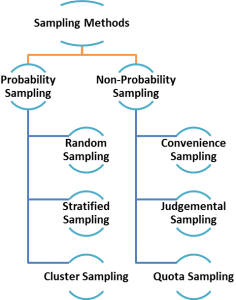Sampling is the process of choosing selective or random items from a known population for studying the characteristics of the Population. Sampling is used because; studying the entire population may be costly, impossible or time-consuming. Therefore, one of the main characteristic of sampling should be to represent the original population without any deviations.
There are various methods available for Sampling. The mainly used ones are described below:

As the name implies, Probability sampling techniques use the science of Probability for picking samples and arriving at sample size, whereas, the Non-probability sampling techniques are more naïve and used as per convenience and requirement. Probability sampling methods provide more accuracy and reliability compared to non-probability sampling.
Non-Probability Sampling:
Convenience Sampling: This method is used when the availability of samples is rare and costly. Thus based on convenience, the samples are selected.
Judgemental Sampling: the process of selecting samples perceiving that certain samples will suit or do not suit a condition. This method uses the researcher’s knowledge, experience in judging or choosing the sample.
Quota Sampling: The method of selecting samples to increase the proportion or representativeness of a certain group or population.
Probability Sampling:
Random Sampling: The process of selecting samples in random & without any particular order or classification. All elements of the population have equal chances of getting picked. This is the most used method of all methods.
Stratified Sampling: When the population is subdivided into groups or sub-populations, and samples need to be picked from each strata (subgroup), this method is used. Each subgroup is a population by itself and exhibit difference between groups.
Cluster Sampling: The population is divided into clusters that represent the original population, and samples are taken from each cluster. The clusters do not show any difference between themselves.
